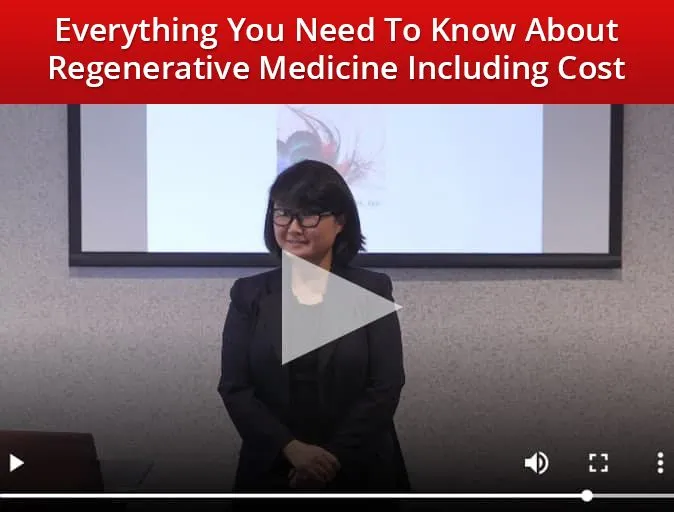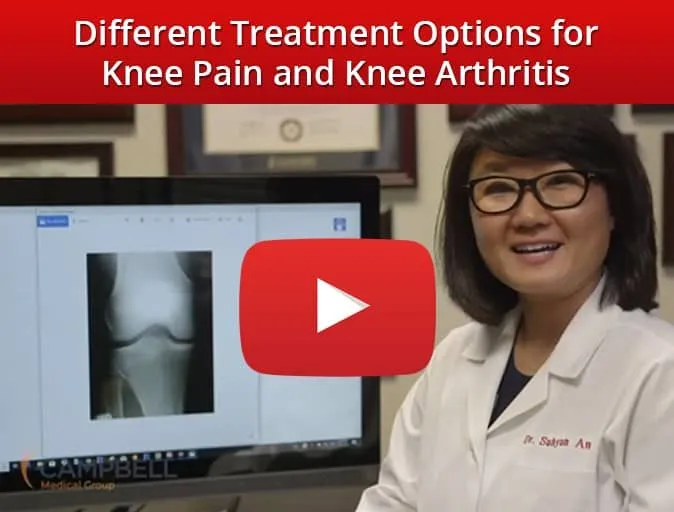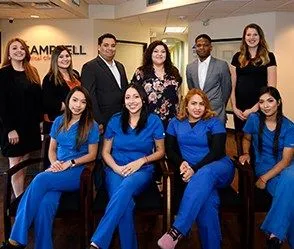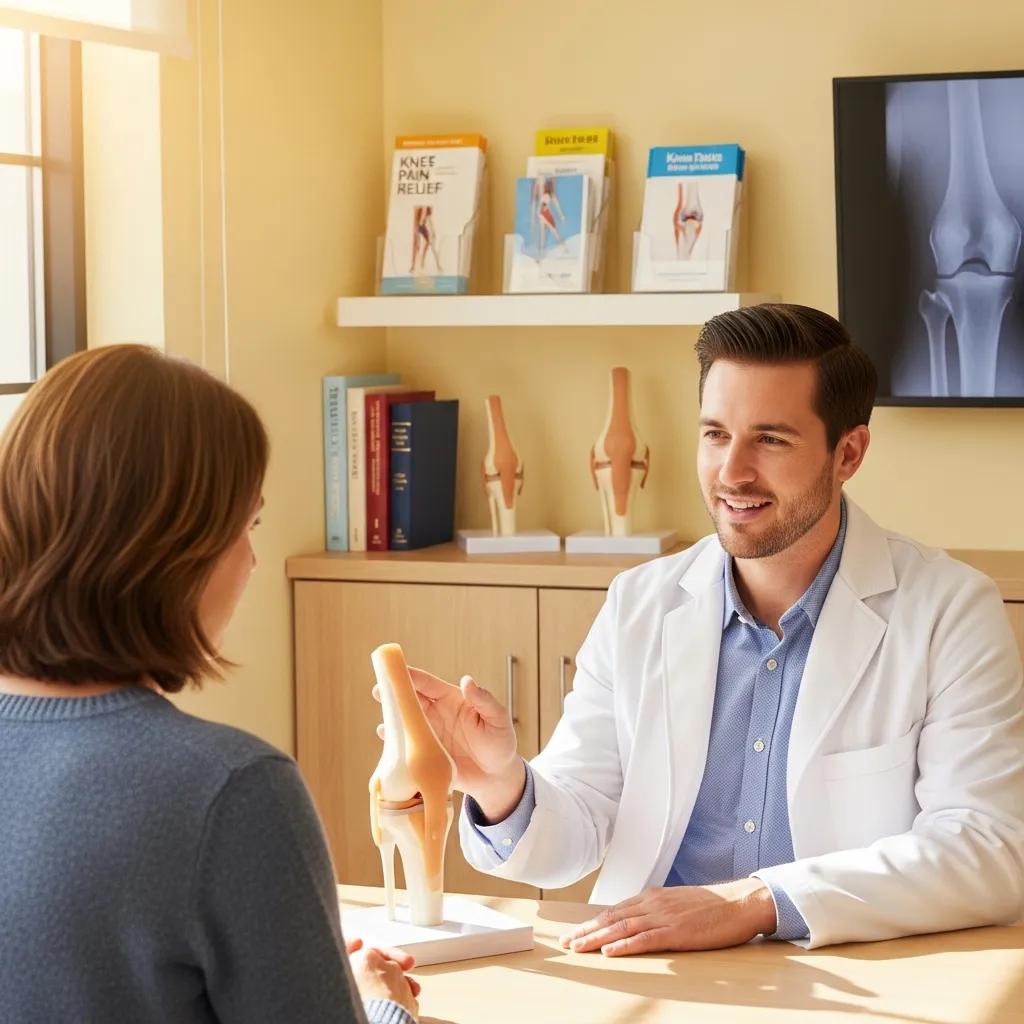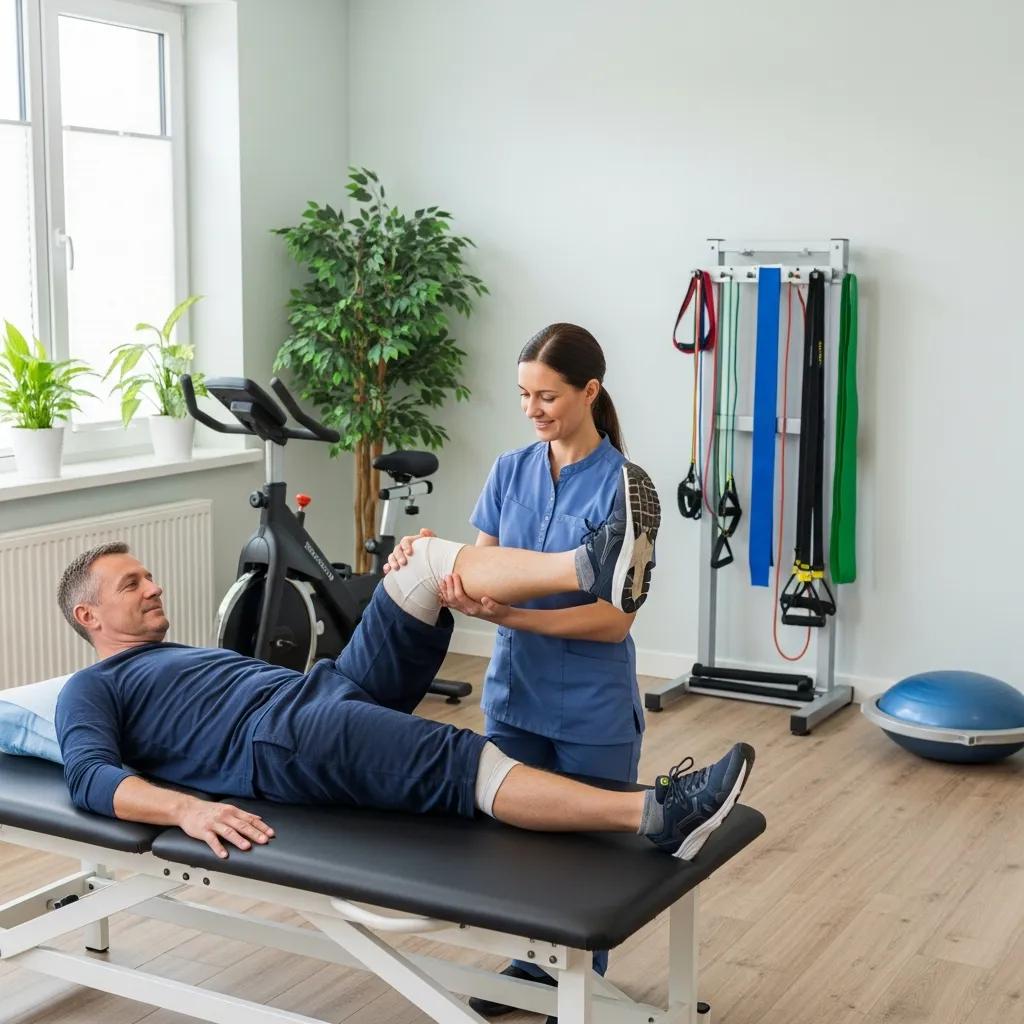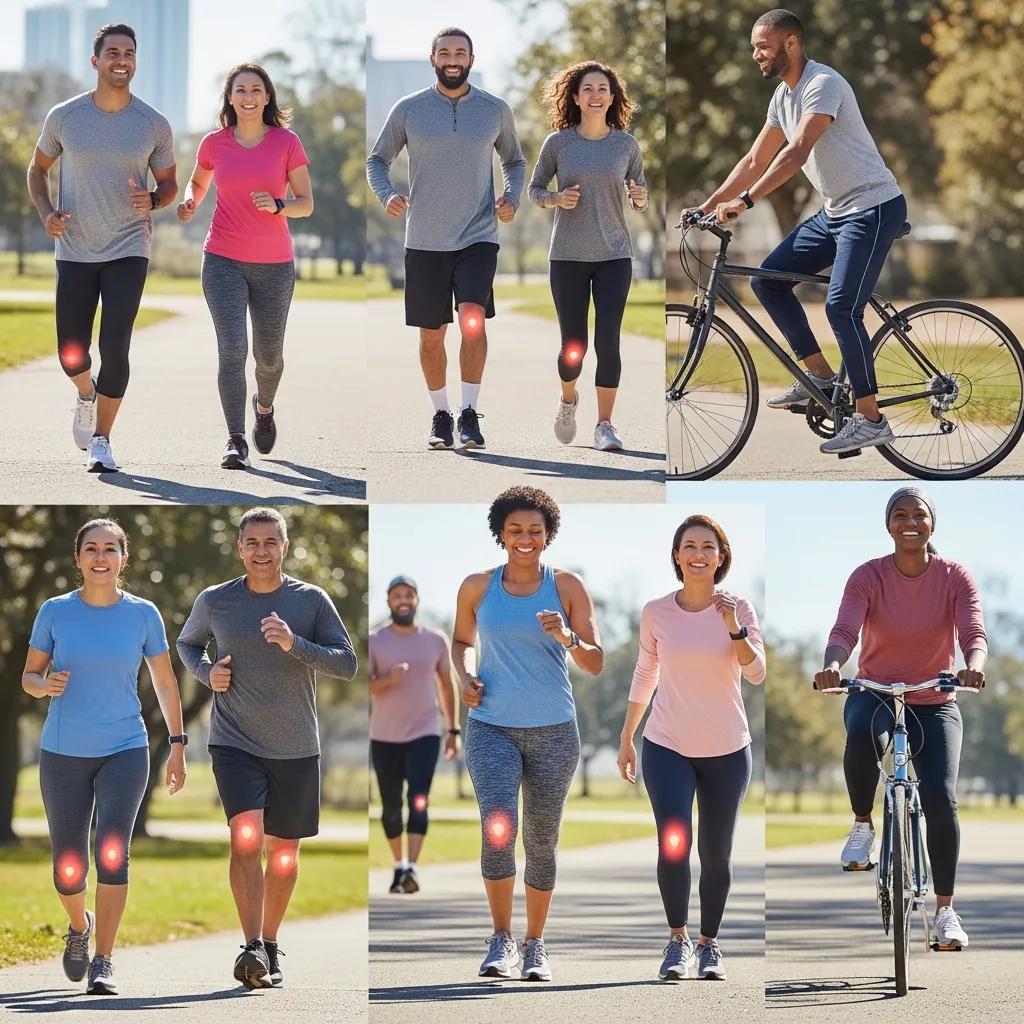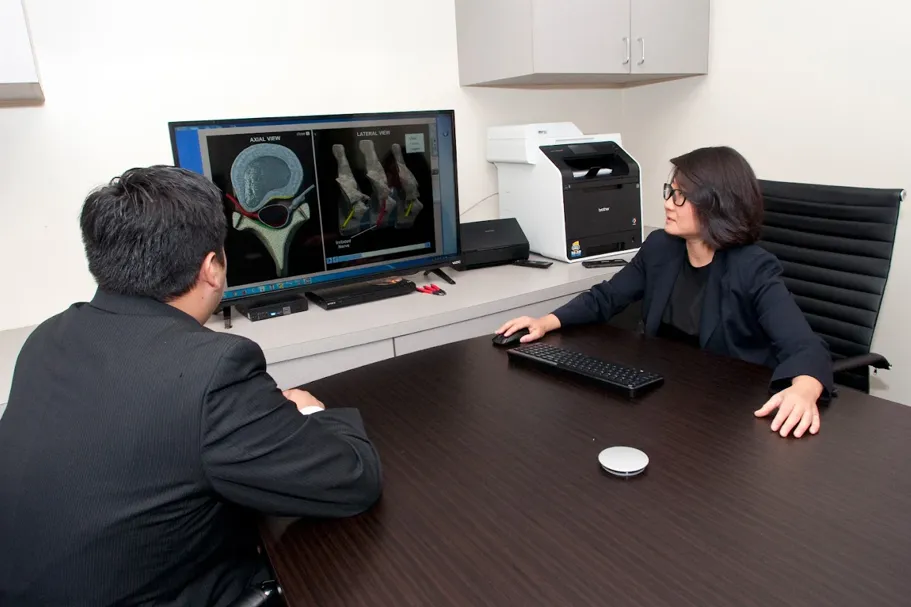
Advanced Non-Surgical Pain Relief Solutions in Houston
Explore effective non-surgical solutions for both sudden and ongoing pain right here in Houston, Texas. At Campbell Health Center, owned by Dr. Suhyun An, we specialize in advanced, minimally invasive therapies designed to alleviate your discomfort, restore your body’s natural function, and promote lasting wellness, all without the need for surgery or reliance on pain medications. This guide will walk you through the various treatment options available, highlighting the significant advantages of choosing non-surgical care, especially cutting-edge regenerative medicine like PRP and stem cell therapy, alongside innovative rehabilitation treatments such as PEMF (Pulsed Electromagnetic Field) therapy, red light therapy, and shockwave therapy. We’ll discuss how these treatments apply to specific conditions, help you understand if you’re a good candidate, detail what to expect during your treatment journey, share insights from fellow patients, and explain how to easily schedule your initial consultation. By understanding these key aspects, you’ll see why opting for non-surgical pain relief can lead to a quicker return to your life, fewer risks, and a personalized care plan guided by our expert team, helping you avoid surgery and chronic pain medication.
What Advanced Non-Surgical Pain Relief Options Are Available in Houston, Texas?
Our Houston, Texas clinic offers a comprehensive range of advanced non-surgical pain relief methods, with a strong emphasis on cutting-edge regenerative medicine like PRP and stem cell therapy, and innovative rehabilitation treatments such as PEMF (Pulsed Electromagnetic Field) therapy, red light therapy, and shockwave therapy. We also provide specialized physical therapy, precise injection techniques like nerve blocks and steroid treatments, expert chiropractic adjustments, and radiofrequency ablation. Each of these approaches is carefully selected to target your specific pain pathways without surgery or the need for ongoing pain medications, aiming to reduce inflammation, accelerate tissue healing, and improve your overall mobility.
| Treatment Method | How It Works | What to Expect |
|---|---|---|
| Regenerative Medicine (PRP & Stem Cell) | Stimulating natural healing factors & tissue repair | Promoting deep tissue repair and regeneration, avoiding surgery |
| PEMF Therapy | Utilizing pulsed electromagnetic fields | Reducing inflammation, accelerating healing at a cellular level, helping you avoid surgery and pain medication. |
| Red Light Therapy | Applying specific wavelengths of light | Enhancing cellular energy, reducing pain and inflammation, without the need for surgery or medication. |
| Shockwave Therapy | Delivering targeted acoustic waves | Stimulating tissue repair and reducing chronic pain, offering a non-surgical path to relief. |
| Physical Therapy | Strengthening muscles & improving movement | Enhanced flexibility and function, reducing reliance on medication |
| Steroid & Nerve Block Injections | Reducing inflammation & blocking pain signals | Targeted pain interruption for relief, as an alternative to surgery |
| Chiropractic Care | Aligning the spine & joints | Decreased nerve irritation and improved posture, naturally, avoiding surgery and medication. |
| Radiofrequency Ablation | Gently disabling pain-transmitting nerves | Sustained relief from chronic pain, without invasive surgery |
This overview showcases the diverse and effective non-surgical strategies we employ to address pain at its root cause, setting the stage for a deeper dive into each specialized treatment.
Which Advanced Non-Surgical Treatments Does Campbell Health Center Offer?
At Campbell Health Center, led by Dr. Suhyun An, we provide personalized physical therapy programs, advanced platelet-rich plasma (PRP) and stem cell injections, precisely administered nerve blocks and steroid injections, expert chiropractic care, radiofrequency ablation, and cutting-edge rehabilitation treatments including PEMF therapy, red light therapy, and shockwave therapy to effectively manage a wide spectrum of musculoskeletal and neuropathic pain conditions, helping patients avoid surgery and chronic pain medications.
How Does Physical Therapy Help Manage Pain Without Surgery?
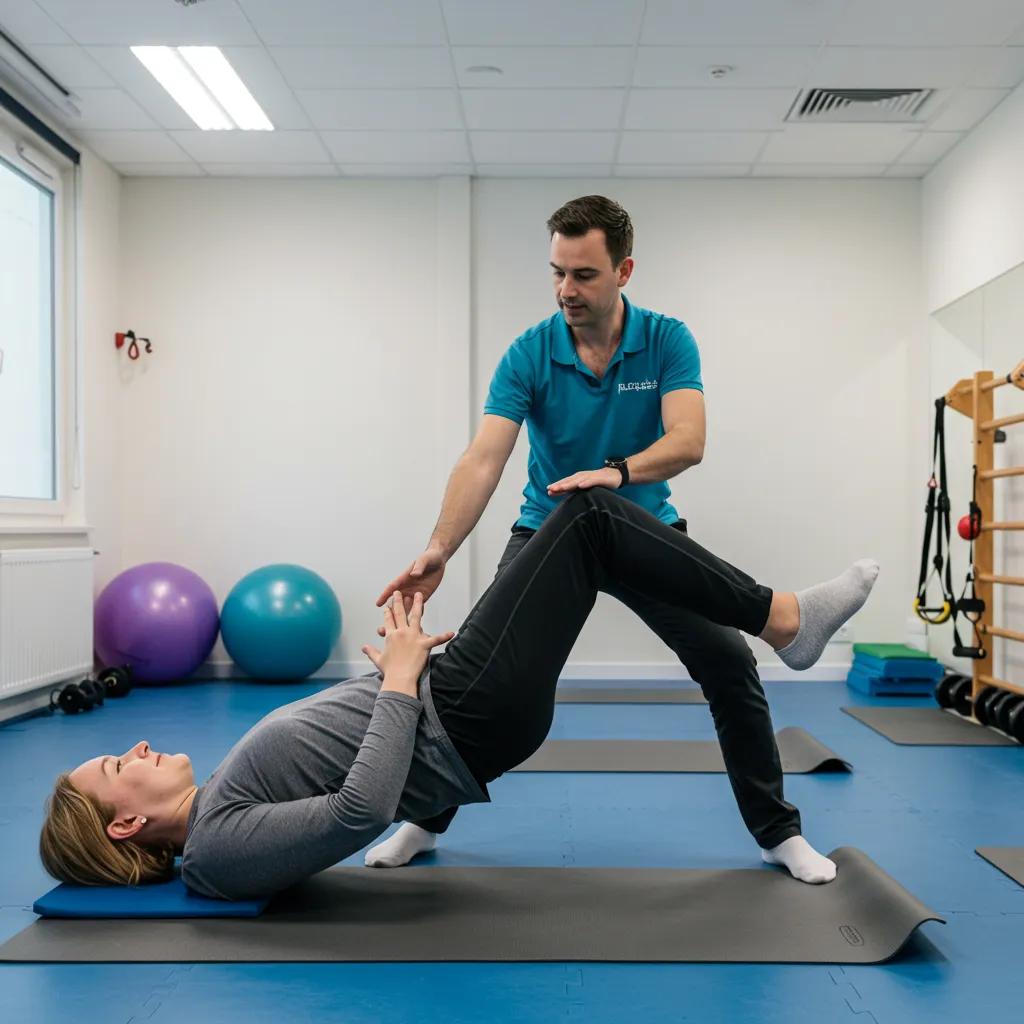
Physical therapy is instrumental in pain management by strengthening the muscles that support your joints, increasing flexibility, correcting inefficient movement patterns, and reducing inflammation through tailored exercises and hands-on techniques.
What Is Regenerative Medicine and How Does It Relieve Pain?
Regenerative medicine, utilizing treatments like PRP and stem cell injections, harnesses your body’s own healing potential. By delivering concentrated growth factors directly to the site of injury or degeneration, these therapies stimulate tissue repair, reduce inflammation, and help restore the function of joints and soft tissues, offering a powerful alternative to surgery and long-term pain medication.
How Do Injections Like Nerve Blocks and Steroids Provide Pain Relief?
Nerve block injections work by temporarily blocking pain signals from specific nerves, offering diagnostic insights and immediate relief. Steroid injections deliver potent anti-inflammatory medication directly to the painful area, quickly reducing swelling and alleviating discomfort for improved function.
What Role Does Chiropractic Care Play in Non-Surgical Pain Management?
Chiropractic care focuses on restoring proper alignment and function to the spine and joints through manual adjustments and mobilization techniques. This approach can relieve pressure on nerves, improve biomechanics, and support your body’s innate ability to heal, all without surgical intervention.
How Does Radiofrequency Ablation Work for Chronic Pain Relief?
Radiofrequency ablation (RFA) is a minimally invasive procedure that uses targeted radiofrequency energy to create heat, which then gently interrupts the nerve pathways responsible for transmitting chronic pain signals. This effectively provides long-lasting relief for conditions affecting the spine and other joints.
What Are the Key Benefits of Choosing Non-Surgical Pain Management?
Non-surgical pain management offers a variety of key benefits that make it an appealing choice for individuals seeking relief from chronic pain without the risks associated with surgical procedures or the side effects of chronic pain medications. One of the primary advantages is the reduced risk of complications and side effects. Surgical interventions often come with potential hazards, including infection, prolonged recovery times, and unexpected outcomes. In contrast, non-surgical methods such as physical therapy, acupuncture, and chiropractic care typically involve minimal risk and often promote a quicker return to daily activities. Additionally, these approaches emphasize holistic and individualized treatment plans, allowing practitioners to tailor therapies based on each person’s unique circumstances and needs.
Another significant benefit of non-surgical pain management is the ability to address underlying issues without the need for invasive techniques. Many non-surgical options focus on rehabilitation and strengthening, which can lead to long-term pain relief and improved function. For example, physical therapies not only target pain relief but also aim to restore mobility and prevent future injuries through exercises and education about proper body mechanics. Furthermore, non-surgical treatments can often be used in conjunction with each other, providing comprehensive care that enhances effectiveness. This integrative approach empowers patients to take an active role in their recovery, fostering a sense of control and engagement in managing their health. Overall, non-surgical pain management represents a holistic, effective, and safer alternative for those looking to alleviate pain and improve their quality of life, ultimately empowering individuals to regain control over their lives without the risks associated with surgery or the need for continuous medication.
Opting for non-surgical pain management offers significant advantages, including a faster return to your daily activities, a substantially lower risk of complications compared to surgery, freedom from chronic pain medications, greater cost-effectiveness, highly personalized treatment plans, and the potential for long-term, sustainable pain relief through targeted, less invasive methods.
| Key Advantage | How It’s Achieved | What It Means for You |
|---|---|---|
| Reduced Recovery Time | Utilizing minimally invasive techniques | Get back to your life sooner, without prolonged downtime |
| Lower Risk of Complications | Avoiding general anesthesia and large incisions | Fewer potential adverse events compared to surgery |
| Freedom from Pain Medication | Addressing root causes and promoting natural healing | Sustainable relief without reliance on pharmaceuticals |
| Cost-Effectiveness | Outpatient procedures and efficient treatment | Lower overall healthcare expenses |
| Personalized Treatment | Customized therapy plans and dosages | Optimized results tailored to you |
| Long-Term Efficacy | Promoting tissue healing and functional recovery | Sustained pain reduction and improved health |
This comparison highlights how non-surgical approaches translate into tangible benefits for your health and well-being. Let’s explore these advantages in more detail.
How Does Non-Surgical Pain Relief Reduce Recovery Time?
Non-surgical therapies are designed to minimize trauma to the body. By using outpatient procedures and focusing on exercise-based rehabilitation, patients can often resume their normal activities within days, rather than the weeks or months typically required after surgery.
Why Is Non-Surgical Treatment Safer Than Surgery?
Non-surgical interventions significantly reduce risks by avoiding the need for general anesthesia and large surgical incisions. This leads to lower rates of infection, less bleeding, and a diminished chance of experiencing postoperative complications.
How Cost-Effective Are Non-Surgical Pain Relief Options?
Non-surgical treatments are generally more affordable than surgical procedures. They often involve lower facility fees, shorter treatment durations, and less need for extensive follow-up care, resulting in significant savings.
Can Non-Surgical Treatments Be Customized for Individual Pain Conditions?
Absolutely. Our specialists at Campbell Health Center excel at creating personalized treatment plans. We base these plans on detailed diagnostic imaging, thorough functional assessments, and your specific health goals to ensure the most effective and comfortable treatment for you.
What Are the Long-Term Outcomes of Non-Surgical Pain Management?
Research indicates that combining regenerative therapies with comprehensive rehabilitation can lead to lasting pain reduction, improved joint health, and a significantly enhanced quality of life that can be sustained for months and even years.
How Does Non-Surgical Pain Relief Address Common Chronic Pain Conditions?
Non-surgical pain relief techniques have gained popularity as effective alternatives for managing chronic pain conditions, addressing a variety of ailments without the need for invasive procedures or reliance on daily pain medications. These methods encompass a range of therapies such as physical therapy, acupuncture, chiropractic care, and the use of non-steroidal anti-inflammatory drugs (NSAIDs). By focusing on the underlying causes of pain, rather than merely alleviating symptoms, non-surgical approaches promote healing, improve functionality, and enhance overall quality of life. For instance, physical therapy exercises are specifically designed to strengthen muscles and improve flexibility, thereby reducing strain on affected areas. Acupuncture, on the other hand, targets specific points in the body to release endorphins and alleviate pain naturally.
Moreover, non-surgical pain relief offers a holistic approach that often includes lifestyle modifications and education on managing chronic pain. Techniques such as mindfulness and cognitive-behavioral therapy help individuals develop coping strategies to decrease the emotional and psychological burden that often accompanies chronic pain. This integrative method allows for a personalized treatment plan tailored to individual needs, contributing to sustainable pain management. By addressing both physical symptoms and emotional well-being, non-surgical interventions aim to create a comprehensive framework for managing chronic pain, ultimately empowering individuals to regain control over their lives without the risks associated with surgery.
Non-surgical pain relief effectively targets chronic pain conditions by addressing the underlying causes of inflammation, promoting natural tissue healing, and restoring optimal function through carefully tailored therapeutic interventions.
| Common Chronic Condition | Recommended Non-Surgical Approach | How It Improves Function |
|---|---|---|
| Chronic Back Pain | Physical therapy, Radiofrequency Ablation (RFA), and PEMF Therapy | Strengthens spinal support, reduces pain signals, and promotes cellular healing |
| Chronic Joint Pain | PRP injections, targeted exercise, and Red Light Therapy | Encourages cartilage repair, boosts joint mobility, and reduces inflammation |
| Neuropathy Pain | Nerve blocks, regenerative injections, and Shockwave Therapy | Calms overactive nerves, supports nerve healing, and stimulates nerve regeneration |
| Reduced Mobility Issues | Chiropractic care, therapeutic exercise, and PEMF Therapy | Enhances range of motion, movement efficiency, and cellular recovery |
This table illustrates how matching specific non-invasive treatments to particular chronic conditions can lead to substantial improvements in comfort and mobility.
What Non-Surgical Treatments Are Effective for Chronic Back Pain in Houston, Texas?
For chronic back pain, we often recommend a combination of physical therapy focused on core strengthening, radiofrequency ablation, and PEMF therapy. This dual approach stabilizes the spine while effectively interrupting pain signals and promoting deep tissue healing for targeted relief.
How Can Non-Surgical Options Help with Chronic Joint Pain?
Platelet-rich plasma (PRP) injections, combined with a personalized exercise program and red light therapy, can significantly help manage chronic joint pain. PRP promotes the repair of damaged cartilage and reduces inflammation within the joint, restoring its ability to bear weight and move smoothly.
Managing early osteoarthritis frequently prioritizes non-surgical methods to address degeneration and enhance function.
Non-Surgical Management of Early Osteoarthritis: A Comprehensive Approach
Non-surgical treatments are usually the first choice for the management of knee degeneration, especially in the early osteoarthritis (OA) phase when no clear lesions or combined abnormalities need to be addressed surgically. Early OA may be addressed by a wide range of non-surgical approaches, from non-pharmacological modalities to dietary supplements and pharmacological therapies, as well as physical therapies and novel biological minimally invasive procedures involving injections of various substances to obtain a clinical improvement and possibly a disease-modifying effect.
Non-surgical treatments for the management of early osteoarthritis, G Filardo, 2016
What Are the Non-Surgical Solutions for Neuropathy Pain?
For neuropathy pain, whether caused by diabetes or nerve compression, we offer targeted nerve block injections, regenerative medicine therapies, and shockwave therapy. These treatments aim to reduce nerve inflammation, promote the healing of damaged peripheral nerves, and stimulate nerve regeneration.
How Do These Treatments Improve Mobility and Quality of Life?
By effectively reducing pain intensity and enhancing joint stability, our non-surgical interventions empower you to move more freely. This means less discomfort when walking, lifting, and engaging in everyday activities, leading to a significantly improved quality of life, without the need for surgery or continuous pain medication.
Who Is a Good Candidate for Non-Surgical Pain Relief at Campbell Health Center?
Ideal candidates for non-surgical pain relief at Campbell Health Center include individuals experiencing musculoskeletal or neuropathic pain who prefer conservative treatments, have reasons to avoid surgery or chronic pain medications, or are seeking a faster return to full function. Our comprehensive evaluation ensures we identify the best approach for your unique needs.
| Candidate Profile | Our Diagnostic Process | What You Can Achieve |
|---|---|---|
| Experiencing acute or chronic pain | Detailed medical history review and physical examination | Accurate identification of your pain’s source |
| Seeking to avoid surgery and pain medication | Review of imaging studies (X-rays, MRIs) | Confirmation that non-surgical options are suitable |
| Overall health supports procedures | Functional movement assessment | Development of a precisely tailored therapy plan |
| Requiring personalized recovery | Evaluation of your personal goals and lifestyle | Creation of an optimized roadmap for recovery |
This framework guides our clinical assessment to ensure you receive the most appropriate and effective non-surgical care.
What Are the Diagnostic Steps Before Starting Non-Surgical Treatment?
Your journey begins with a thorough evaluation, including a review of your medical history, a comprehensive physical examination, and advanced imaging studies. This process helps us pinpoint the exact source of your pain and rule out any contraindications for treatment.
Which Pain Conditions Are Best Treated Without Surgery?
Many conditions, such as mild to moderate osteoarthritis, muscle strains, nerve irritation, and early-stage tendinopathies, respond exceptionally well to our non-invasive therapeutic options, helping patients avoid surgery and chronic pain medications.
How Do Specialists at Campbell Health Center Personalize Pain Management Plans?
Under the direct oversight of Dr. Suhyun An, our clinicians meticulously integrate your diagnostic findings with your personal goals, lifestyle considerations, and functional assessments to craft a truly individualized treatment strategy designed for maximum effectiveness and comfort, with the aim of avoiding surgery and pain medication.
When Should Patients Consider Surgery Instead of Non-Surgical Options?
Surgery might be recommended if conservative treatments haven’t provided sufficient relief after a dedicated trial period, or if significant structural damage requires reconstructive intervention.
What Can Patients Expect During and After Non-Surgical Pain Treatments?
When patients engage in non-surgical pain treatments, such as physical therapy, regenerative medicine, or advanced rehabilitation therapies, they can anticipate a well-structured therapeutic experience designed to enhance their comfort and facilitate recovery. Initially, patients will often undergo a comprehensive assessment during their first consultation, where healthcare providers will gather detailed information about their medical history and specific pain issues. This initial evaluation is crucial in crafting a personalized treatment plan tailored to the patient’s unique needs. During the treatment sessions, patients may experience varying sensations, ranging from mild discomfort to relief, depending on the method employed. Most non-surgical treatments are designed to be minimally invasive, focusing on alleviating pain through natural means, and they often come with the benefit of fewer risks and quicker recovery times compared to surgical interventions or reliance on pain medications.
After completing non-surgical treatments, patients can expect a gradual improvement in their pain levels and functionality. However, it is important for them to maintain realistic expectations about the recovery timeline, as results can vary significantly among individuals. Many treatments require multiple sessions for optimal benefits, and ongoing home exercises or lifestyle modifications may be recommended to support long-term pain relief. Patients should be proactive in communicating any concerns or side effects they experience during or after treatment, as this feedback can help practitioners make necessary adjustments to their care plan. Ultimately, the goal of non-surgical pain treatments is not just to reduce pain, but also to empower patients in managing their condition and improving their overall quality of life, free from surgery and chronic pain medication.
At Campbell Health Center, we ensure you’re well-informed throughout your non-surgical treatment journey. We provide clear guidance on procedures, realistic recovery timelines, and ongoing support to help you achieve the best possible outcomes.
| Stage of Treatment | Typical Experience | Our Support System |
|---|---|---|
| Physical Therapy Session | Warm-up, targeted exercises, manual therapy | Monitoring your progress and providing home exercise plans |
| PRP or Stem Cell Procedure | Preparation of your sample, guided injection | Clear instructions for post-procedure care |
| PEMF, Red Light, Shockwave Therapy | Non-invasive application to target area | Guidance on session frequency and complementary care |
| Recovery Timeline | Gradual return to activities over 1–4 weeks | Scheduled check-ins and therapy adjustments |
| Potential Risks & Side Effects | Mild soreness, temporary swelling | Guidance on managing any temporary symptoms |
| Comprehensive Patient Support | Education, encouragement, and close monitoring | Continuous access to our dedicated care team, focused on helping you avoid surgery and chronic pain medication. |
This detailed overview prepares you for every phase of your treatment, highlighting the integrated support you’ll receive every step of the way.
How Is a Typical Physical Therapy Session Structured?
Each session begins with an assessment and warm-up, followed by targeted strengthening and flexibility exercises. We often incorporate manual therapy techniques to enhance your progress and conclude with guidance on continuing your exercises at home.
What Is the PRP or Stem Cell Therapy Procedure Like?
For PRP or stem cell therapy, we first prepare the concentrated growth factor or stem cell solution from your sample. Then, using advanced imaging guidance, our specialists precisely inject the therapeutic material into the affected area under strict sterile conditions.
What Are the Recovery Timelines for Common Non-Surgical Treatments?
Most patients can resume light daily activities within a few days following injection therapies. Full recovery and the benefits of rehabilitation exercises are typically experienced over two to four weeks.
What Are Possible Risks and Side Effects of Non-Surgical Pain Relief?
Non-surgical interventions are associated with minimal risks. Potential side effects are usually limited to temporary soreness or mild swelling at the injection site, and any rare allergic reactions typically resolve quickly.
How Does Campbell Health Center Support Patients Through Recovery?
Our dedicated care team provides detailed post-treatment instructions, schedules regular progress assessments, and makes adaptive therapy modifications as needed to ensure you achieve optimal healing and lasting results.
What Do Houston, Texas Patients Say About Their Non-Surgical Pain Relief Experiences?
When it comes to managing chronic pain, many patients in Houston, Texas are exploring non-surgical options and reporting largely positive experiences. Non-surgical pain relief methods, such as physical therapy, regenerative medicine, advanced rehabilitation treatments, and chiropractic treatments, are gaining popularity for their ability to provide symptomatic relief without the risks associated with surgical interventions or the side effects of chronic pain medications. Patients often highlight the personalized approach of non-surgical treatments, where practitioners take the time to understand their unique pain conditions and tailor strategies accordingly. This individualized care leads to a sense of empowerment, as patients become active participants in their healing journey.
Moreover, patient testimonials emphasize the effectiveness of these non-surgical methods in enhancing quality of life. Many find that treatments such as spinal manipulation or targeted physical therapy sessions not only alleviate pain but also improve mobility and function. Notably, Houston, Texas patients appreciate the availability of multidisciplinary options, which allow them to combine different modalities for a more comprehensive approach to pain management. As a result, many report lower levels of anxiety and a greater sense of control over their pain. Overall, the positive feedback regarding non-surgical pain relief options in Houston, Texas underscores the growing shift towards holistic and less invasive treatments in the realm of pain management, helping patients avoid surgery and chronic medication.
Our patients consistently report significant reductions in pain, remarkable restoration of function, and high levels of satisfaction with the non-surgical care they receive at Campbell Health Center.
| Patient Success Story | Treatment Provided | Reported Improvement |
|---|---|---|
| Relief from chronic back pain | Radiofrequency ablation, PEMF Therapy | A 70% reduction in pain intensity, avoiding surgery |
| Enhanced joint mobility | PRP injections, physical therapy, Red Light Therapy | A 50% increase in range of motion, without medication |
| Reduced neuropathy symptoms | Nerve blocks, regenerative therapy, Shockwave Therapy | Significant decrease in tingling and numbness, avoiding surgery |
These inspiring success stories are a testament to our clinic’s expertise and commitment, helping to build confidence for those considering treatment.
Which Success Stories Highlight Effective Non-Surgical Pain Management?
We have numerous patients who previously suffered from knee osteoarthritis but have since regained their active lifestyles thanks to our combined approach of regenerative injections, tailored therapeutic exercise, and advanced rehabilitation therapies.
How Do Patient Testimonials Reflect Campbell Health Center’s Expertise?
Our patient testimonials frequently praise the clinic’s meticulous diagnostic process, a testament to the high standards set by Dr. Suhyun An, and our compassionate approach to care, and proven success in utilizing advanced non-surgical techniques to achieve remarkable patient outcomes, helping them avoid surgery and chronic pain medications.
What Are Common Patient Questions About Non-Surgical Pain Relief?
Patients often ask about the level of discomfort during procedures, the expected recovery timelines, and the best ways to maximize long-term benefits, particularly through consistent home exercise routines and adherence to their personalized treatment plan.
How Can You Schedule a Consultation for Non-Surgical Pain Relief in Houston, Texas?
Scheduling your consultation for non-surgical pain relief in Houston, Texas can be a straightforward process when you know what steps to take. First, it’s important to identify a reputable clinic or healthcare provider that specializes in non-surgical pain management techniques, such as physical therapy, regenerative medicine, advanced rehabilitation therapies, or chiropractic care. Online research can be beneficial; look for reviews and ratings from previous patients to find a provider that suits your needs. Once you’ve narrowed down your options, visit their website or call their office directly to inquire about consultation availability. Many clinics offer online scheduling forms that allow you to choose your preferred date and time, making the process quick and convenient.
During your consultation, be prepared to discuss your medical history, the nature and duration of your pain, and any previous treatments you may have tried. This information will help the healthcare professional tailor a pain relief plan specifically for you, with a focus on avoiding surgery and chronic pain medications. Don’t hesitate to ask questions about the various non-surgical options available, such as regenerative medicine, PEMF, red light therapy, or shockwave therapy, to determine what might work best for your condition. Additionally, please note that we are not covered by insurance or medicare. By taking these steps, you can set yourself up for a productive consultation and a path toward effective pain relief without surgery.
Scheduling your consultation for non-surgical pain relief at Campbell Health Center is a straightforward process. We guide you through a simple intake, provide clear preparation advice, and ensure you connect promptly with a specialist to begin crafting your personalized pain management plan.
| Step in the Process | What You Need to Do | How to Prepare |
|---|---|---|
| Initial Inquiry | Submit your request online or give us a call | Be ready to briefly describe your pain history and goals |
| First Assessment | Complete a confidential health questionnaire | Have recent imaging results available, if possible |
| Consultation with Specialist | Attend your in-office evaluation | Bring any relevant prior medical records |
| Discussing Your Treatment Plan | Review the recommended therapies with your specialist | Prepare any questions you have about your options |
| Scheduling Your Treatment | Confirm your therapy dates | Arrange transportation if needed for appointments |
This step-by-step guide makes it easy to begin your journey toward effective non-surgical pain management at Campbell Health Center.
What Is the Process to Book a Pain Management Consultation?
To book your consultation, simply complete a brief health history form and schedule an appointment with one of our pain specialists. During this visit, we’ll discuss your symptoms and treatment objectives in detail, focusing on non-surgical solutions to help you avoid surgery and pain medications.
What Should Patients Prepare Before Their First Appointment?
Please bring any relevant medical records, previous imaging results (like X-rays or MRIs), and a list of all current medications you are taking. This information is crucial for an accurate diagnosis and effective treatment plan, aimed at providing relief without invasive procedures or chronic pharmaceuticals.
How Does Campbell Health Center Ensure Personalized Care From Day One?
Personalized care is our priority. From your very first consultation, our specialists work closely with you, aligning our therapeutic strategies with your individual needs, preferences, and functional goals, always with the aim of helping you avoid surgery and pain medications.
Choosing non-surgical options at Campbell Health Center, championed by Dr. Suhyun An, offers a clear path to significant pain relief through advanced, minimally invasive therapies and unwavering patient support. By reducing recovery times, minimizing risks, and tailoring treatments to your specific condition, we help patients in Houston, Texas effectively regain function and improve their quality of life without surgery or reliance on pain medications. To discover which non-surgical solution is right for you, connect with our experienced pain specialists today and take the vital first step toward lasting relief.
Frequently Asked Questions
What types of conditions can be treated with non-surgical pain relief methods?
Non-surgical pain relief methods can effectively treat a variety of conditions, including chronic back pain, joint pain, neuropathy, and mobility issues. These treatments are designed to address the underlying causes of pain, such as inflammation and tissue damage, without the need for invasive surgery or chronic pain medications. By utilizing techniques like physical therapy, regenerative medicine (PRP, stem cell), and advanced rehabilitation therapies such as PEMF, red light therapy, and shockwave therapy, patients can experience significant pain reduction and improved function across a wide range of musculoskeletal and neuropathic conditions.
How long does it typically take to see results from non-surgical treatments?
The timeline for seeing results from non-surgical treatments can vary based on the specific method used and the individual patient’s condition. Generally, patients may start to notice improvements within a few days to weeks after treatment. For instance, injection therapies may provide immediate relief, while physical therapy results often become more apparent as patients progress through their rehabilitation program. Continuous monitoring and adjustments to the treatment plan can further enhance outcomes and speed up recovery, helping patients avoid surgery and chronic pain medications.
Are there any lifestyle changes recommended alongside non-surgical treatments?
Yes, lifestyle changes can significantly enhance the effectiveness of non-surgical treatments. Patients are often encouraged to adopt a balanced diet, engage in regular physical activity, and maintain a healthy weight to support their recovery. Additionally, incorporating specific exercises and stretches as advised by healthcare professionals can improve mobility and strength. These changes not only aid in pain management but also contribute to overall well-being and long-term health benefits, reducing the need for surgery or pain medications.
What should patients expect during their first consultation?
During the first consultation at Campbell Health Center, patients can expect a comprehensive evaluation that includes a detailed medical history review and a physical examination. The specialist will discuss the patient’s symptoms, pain history, and treatment goals, with a focus on helping them avoid surgery and pain medications. Diagnostic imaging may be reviewed to better understand the underlying issues. This initial assessment is crucial for developing a personalized treatment plan tailored to the patient’s specific needs and conditions.
How can patients maximize the benefits of their non-surgical treatments?
To maximize the benefits of non-surgical treatments, patients should actively participate in their recovery process. This includes adhering to prescribed therapy sessions, following home exercise plans, and maintaining open communication with their healthcare team. Additionally, patients should prioritize rest and recovery, manage stress levels, and avoid activities that may exacerbate their condition. By taking these proactive steps, patients can enhance their healing and achieve better long-term outcomes, ultimately avoiding surgery and chronic pain medications.
What follow-up care is provided after non-surgical treatments?
Follow-up care is an essential component of the non-surgical treatment process. After initial treatments, patients will typically have scheduled check-ins to monitor their progress and assess the effectiveness of the therapy. During these follow-ups, healthcare providers may adjust treatment plans as needed, provide additional guidance on exercises, and address any concerns or questions. This ongoing support ensures that patients stay on track toward achieving their pain management goals and overall recovery, with the ultimate aim of avoiding surgery and long-term medication.

